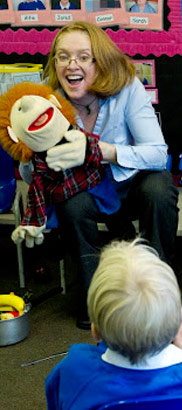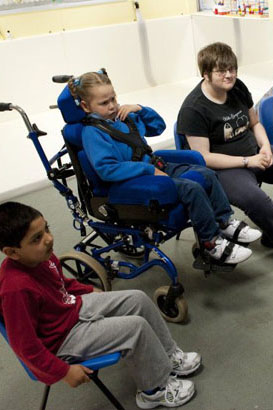
The story must engage children. If it doesn't, stop and start another. For children with PMLD, the best stories to tell are short, simple and involve lots of repetition. Look at The
Gruffalo and We’re Going on a Bear Hunt. These are essentially the same short scenario repeated several times and building
to a crescendo.
Points to remember:
- Don't be concerned about 'age appropriateness'. Any story can be adapted for its intended age group. For example, try adapting Little Red Riding Hood for 14-year-olds. It's all about the 'wolf' that mothers don't want their daughters to go out with.
- When you've told the story at the beginning of the session, encourage each pupil to tell the story themselves by sitting in the storyteller's chair. You'll need to help them a lot at first, but you can act as the 'response' to their 'call' by mirroring what they say and giving it value.

Repeat the storytelling format for several weeks, perhaps breaking up the sessions by making a picture book, using a PowerPoint
presentation, or filming scenes with children as the actors.
The aim here is to teach children that stories have a structure (beginning and middle and end), high points and a conclusion,
and an audience. This latter point is really important since the best storytellers take their audience with them and include
them as part of the story.
As children improve their storytelling skills, they can start to make up their own stories about real events that relate
to them. In other words, they can tell their own stories about their own lives.
Storytelling in
practice (3)

Once you’ve firmly established basic storytelling skills through short, exciting, dramatic fictions, talk to children's
families (during parents evenings etc.) about special events and stories that the family might relate at home.
Give ownership of everyday stories to the children. These are the stories that are normally kept in the staffroom, the home,
or respite centre, for example.
Encourage staff to write down the events that happen to our students, specially if they are funny, scary, dramatic etc.

Start a 'storytelling box' to keep in the staff room where stories can be posted. Involve the children as much as possible
in writing their stories.
Storyboard these stories into short books using real characters as much as possible.
Video two- or three-minute narrations to show in the same way we might tell a favourite anecdote.

Grove, N. (2005) Ways into Literature: Stories, Plays and Poems for Pupils with SEN, London: David Fulton.
Grove, N. (2010) The Big Book of Storysharing, London: Senjit.
Grove, N. (ed) (2012) Bringing Literature to Life: Introducing a Range of Approaches for Teachers of Children with Special
Educational Needs, London: Routledge. tell a favourite anecdote.